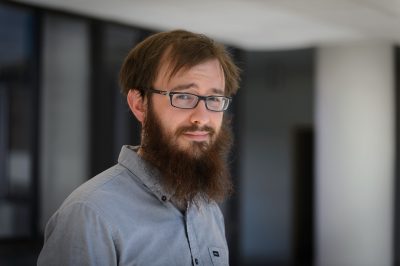
As a theoretical physicist studying the fundamental elements of matter, UConn graduate student Daniel Hoying creates calculations so large and complex they require supercomputers to perform them.
So Hoying is obviously excited that he will soon have regular access to one of the world’s most powerful supercomputers at the U.S. Department of Energy’s Brookhaven National Laboratory in Long Island, N.Y. The system is outfitted with Intel’s powerful new Knights Landing Xeon Phi chip. The chip’s 8 billion transistors and other cutting-edge technologies can carry the heavy processing loads that scientists like Hoying need to do their work.
“This represents an enormous opportunity for me,” says Hoying, who is headed to Brookhaven as a recipient of a U.S. Department of Energy (DOE) Office of Science Graduate Student Research (SCGSR) Award. “The level of precision offered by these processors allows us to make calculations that we would never have conceived of a few years ago. The on-site expertise can’t be discounted either. There are a lot of people there who know a lot of things I don’t know. It’s very exciting to have an opportunity to learn from them.”
Starting in July, Hoying will spend 12 consecutive months conducting part of his dissertation research at Brookhaven. Only 53 graduate students around the country received SCGSR awards this year. Other winners included students from Yale, Princeton, MIT, Duke, Cornell, CalTech, and Michigan State.
“The SCGSR program prepares graduate students for science, technology, engineering, or mathematics (STEM) careers critically important to the DOE Office of Science’s mission,” says Steve Binkley, acting director of DOE’s Office of Science. “We are proud of the accomplishments these outstanding students already have made, and look forward to following their achievements in years to come.”
Hoying’s research focuses on the Standard Model of particle physics. The Standard Model explains how the basic building blocks of matter interact and are governed by fundamental forces such as gravity and electromagnetism. It is the most fundamental theory of nature.
Hoying specifically studies the strong force in the Standard Model, otherwise known as Quantum Chromodynamics or QCD. The strong force binds fundamental particles of matter together to form larger particles. For example, the strong force helps quarks and gluons combine to make protons and neutrons, which in turn combine to make atoms, which in turn combine to make molecules and so on.
He is currently looking at the decaying cycle of particles known as kaons, which decay into two other particles called pions. These extremely small particles, first discovered in cosmic rays, only exist for fractions of a second and have been identified in experiments run in large particle accelerators. They are an essential part of the Standard Model of particle physics.
Previous calculations have shown that theory and experiments involving the decay of kaons have differed by small amounts. Hoying’s research aims to reduce those uncertainties, to help scientists learn more about what these particles are and how they behave.
Besides increasing understanding and advancing basic science, ultimately the information gathered through Hoying’s research could have a variety of applications in advanced computing and various energy fields.
“Dan is a talented young physicist who works hard,” says Professor Thomas Blum, Hoying’s advisor in the Department of Physics. “I’m fortunate to have him working for me.”
This article by Colin Poitras (UConn Communications) appeared in UConn Today on April 17, 2016.